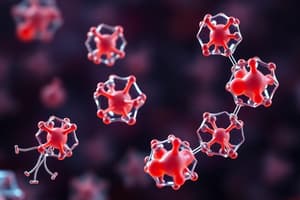Podcast
Questions and Answers
What is the main product of the ornithine cycle in plants?
What is the main product of the ornithine cycle in plants?
- Citrulline
- Urea
- Allantoin (correct)
- Arginine
Where does the first reaction of the urea cycle, involving Carbamoyl Phosphate Synthetase, take place?
Where does the first reaction of the urea cycle, involving Carbamoyl Phosphate Synthetase, take place?
- Endoplasmic Reticulum
- Cytoplasm
- Mitochondria (correct)
- Golgi Apparatus
Which enzyme is responsible for converting citrulline to arginine in the urea cycle?
Which enzyme is responsible for converting citrulline to arginine in the urea cycle?
- Argininosuccinate Synthetase (correct)
- Ornithine Transcarbamylase
- Arginase
- Carbamoyl Phosphate Synthetase
During which stage of the urea cycle do amino transferases help transport ammonium and other compounds across cellular membranes?
During which stage of the urea cycle do amino transferases help transport ammonium and other compounds across cellular membranes?
Which of the following enzymes is NOT involved in the urea cycle?
Which of the following enzymes is NOT involved in the urea cycle?
What is the role of ornithine transcarbamylase in the urea cycle?
What is the role of ornithine transcarbamylase in the urea cycle?
Which vitamin derivative is required for the activity of ornithine transcarbamylase?
Which vitamin derivative is required for the activity of ornithine transcarbamylase?
What is the product of the reaction catalyzed by argininosuccinate lyase?
What is the product of the reaction catalyzed by argininosuccinate lyase?
Which step in the urea cycle releases two additional ammonium groups?
Which step in the urea cycle releases two additional ammonium groups?
What is the final product of the urea cycle that is released into the bloodstream for removal from the body?
What is the final product of the urea cycle that is released into the bloodstream for removal from the body?
Flashcards are hidden until you start studying
Study Notes
The Urea Cycle and Its Key Enzymes
The urea cycle is a vital metabolic process that occurs primarily in liver cells called hepatocytes. It plays a crucial role in removing excess nitrogen from the body through the formation of urea, which is then excreted by the kidneys. This cycle involves several enzymatic reactions and is essential for maintaining the balance of amino acids within our bodies. Let's explore some key aspects of the urea cycle and its related processes.
Ornithine Cycle vs. Urea Cycle
Before diving into the urea cycle itself, it's important to understand the distinction between the ornithine cycle and the urea cycle. While they share many similarities, these cycles operate slightly differently depending on the organism involved. In animals like humans, the urea cycle is responsible for producing urea, while plants produce allantoin instead via the ornithine cycle. Both pathways involve the conversion of citrulline to arginine, with subsequent steps leading to urea production only in animals.
Components of the Urea Cycle
The urea cycle consists of five main enzymes that work together in sequence to perform their function effectively:
-
Carbamoyl Phosphate Synthetase: This first reaction takes place in the mitochondria. An ammonia molecule combines with bicarbonate from carbon dioxide to form carbamyl phosphate. Amino transferases help transport ammonium and other compounds across cellular membranes during this stage.
-
Ornithine Transcarbamylase: Carbamyl phosphate moves out of the mitochondria and reacts with ornithine, forming citrulline and releasing energy in the form of Pi. This step also requires pyridoxal 5'-phosphate, a vitamin B6 derivative.
-
Argininosuccinate Lyase: Citrulline, produced earlier, binds with another ornithine molecule and forms argininosuccinate. This step releases two additional ammonium groups.
-
Arginase: Argininosuccinate breaks down further into fumarate and arginine, releasing one more ammonium group. Fumarate can enter the Krebs cycle to generate ATP through oxidative phosphorylation.
-
Urease: Finally, arginine undergoes hydrolysis to produce urea and regenerates ornithine. Urea is released by the cells into the bloodstream where it travels to the kidneys for removal from the body during the urination process.
Disorders Associated with the Urea Cycle
Disruptions in any of these enzyme activities can lead to various disorders affecting the urea cycle, including citrullinemia type I, hyperornithinemia-hyperammonemia-homocitrullinuria syndrome, argininosuccinic aciduria, and familial hyperargininemia. These conditions often result in elevated levels of ammonia in the blood due to decreased urea production, leading to severe neurological symptoms if left untreated.
In summary, the urea cycle is a complex set of biochemical transformations carried out by specific enzymes in the liver. Understanding how each component works contributes significantly to our knowledge of human physiology and our ability to diagnose and treat diseases associated with impaired urea cycling.
Studying That Suits You
Use AI to generate personalized quizzes and flashcards to suit your learning preferences.




